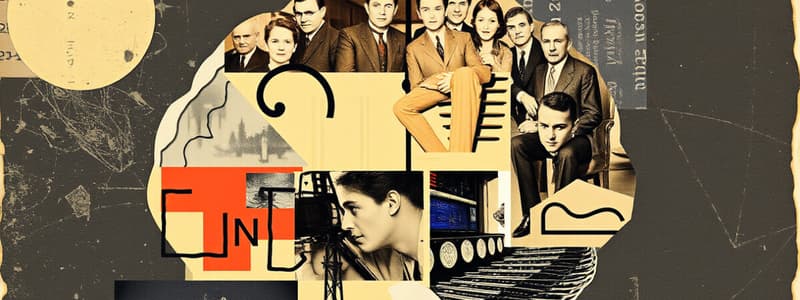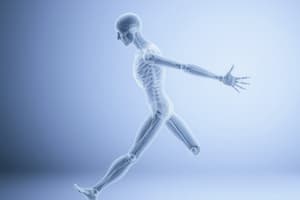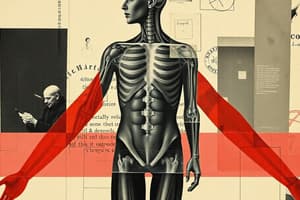Podcast
Questions and Answers
What part of the brain initiates voluntary movements?
What part of the brain initiates voluntary movements?
- Spinal cord
- Cerebellum
- Medulla oblongata
- Cerebral cortex (correct)
Reflex movements are typically initiated in the cerebral cortex and require conscious thought.
Reflex movements are typically initiated in the cerebral cortex and require conscious thought.
False (B)
What is an example of a reflex movement?
What is an example of a reflex movement?
Knee-jerk reaction
Voluntary movements allow individuals to interact with their __________.
Voluntary movements allow individuals to interact with their __________.
Match the type of movement to its characteristics:
Match the type of movement to its characteristics:
How many neurons are involved in the motor pathway from the cortex to the effector?
How many neurons are involved in the motor pathway from the cortex to the effector?
Voluntary movements always involve the same muscles and joints each time.
Voluntary movements always involve the same muscles and joints each time.
What role do physiotherapists play regarding reflexes?
What role do physiotherapists play regarding reflexes?
What is a key factor in linking pathologies to motor impairments?
What is a key factor in linking pathologies to motor impairments?
What should clinicians evaluate to determine intervention effectiveness?
What should clinicians evaluate to determine intervention effectiveness?
Which of the following is likely an aspect of intervention planning for treatable impairments?
Which of the following is likely an aspect of intervention planning for treatable impairments?
Which approach should be taken for non-treatable impairments?
Which approach should be taken for non-treatable impairments?
What clinical presentations should be linked to motor impairments?
What clinical presentations should be linked to motor impairments?
How should motor changes be documented during evaluation?
How should motor changes be documented during evaluation?
What is a common goal when evaluating a client with motor impairments?
What is a common goal when evaluating a client with motor impairments?
What is an important aspect of the clinical reasoning process in relation to motor impairments?
What is an important aspect of the clinical reasoning process in relation to motor impairments?
What is primarily affected by damage in the central nervous system that is under voluntary control?
What is primarily affected by damage in the central nervous system that is under voluntary control?
Which of the following characteristics is associated with extrapyramidal pathways?
Which of the following characteristics is associated with extrapyramidal pathways?
How do feedback loops involving the cerebellum contribute to movement control?
How do feedback loops involving the cerebellum contribute to movement control?
Which system's impairment can affect general capacity and fatigue during movement?
Which system's impairment can affect general capacity and fatigue during movement?
What is a consequence of damage at the level of lower motor neurons?
What is a consequence of damage at the level of lower motor neurons?
Which of the following best describes the relationship between sensory input and motor output?
Which of the following best describes the relationship between sensory input and motor output?
Which condition is associated with muscle wasting as a result of impaired peripheral nervous system function?
Which condition is associated with muscle wasting as a result of impaired peripheral nervous system function?
What role do upper motor neurons play in movement control?
What role do upper motor neurons play in movement control?
Flashcards are hidden until you start studying
Study Notes
Voluntary Movements
- Initiated in the cerebral cortex, these movements involve complex planning and coordination.
- Purposeful and intentional actions enable interaction with the environment (e.g., walking, writing).
- Characterized by redundancy; the same muscles and joints are not always utilized for each movement task.
- Redundancy is significant for motor learning and compensatory mechanisms, aiding function despite movement impairments.
Reflex Movements
- Involuntary and rapid responses to stimuli, typically mediated by the spinal cord or lower brain centers.
- Serve protection and survival functions, occurring without conscious thought.
- Examples include knee-jerk reflex and withdrawal from heat; these are automatic and hardwired.
- Postural reflexes coordinate input from senses like vision and the vestibular system.
Lifespan of Reflexes
- Some reflexes persist throughout life, while developmental reflexes integrate into complex movements as the nervous system matures.
- Reflexes can re-emerge following nervous system injuries, indicating adaptability.
Motor Pathway Details
- Consists of two neurons and one synapse linking the cortex to skeletal muscle in the somatic nervous system.
- Upper motor neuron is part of the corticospinal or corticobulbar tract, facilitating skilled voluntary movement.
- Lower motor neuron, located in the spinal cord, synapses with the muscle at the neuromuscular junction.
- Lower motor neuron functions are always facilitatory; action potentials lead to muscle contraction.
Interneurons and Coordination
- Important interneurons within the spinal cord and connections to the cerebellum play a crucial role in smooth, coordinated movements.
Motor Effects and Nervous System Dysfunction
- Different motor impairments indicate damage or dysfunction within the nervous system and present clinically in various pathologies.
- Identifying the link between impairments and pathologies is essential for guiding intervention planning.
- Some impairments are treatable through physiotherapy or medical interventions, while others require a compensatory approach.
Clinical Reasoning and Measurement
- Objective measurement of impairments is crucial to assess:
- Improvement in the client
- Maintenance of functional capacity
- Deterioration of condition
- Effectiveness of interventions
Pathology and Impairments
- Consider how specific impairments relate to nervous system areas affected and common pathologies producing these signs and symptoms.
Types of Motor Impairments
- Damage in the central nervous system (CNS):
- Affects voluntary motor pathways controlling motor planning (praxis) and voluntary actions.
- Non-voluntary control dysfunction in the CNS:
- Results in altered tone (rigidity, spasticity, clonus), reflex movement issues, and tremors.
- Damage in the peripheral nervous system (PNS):
- Causes deficits in strength, muscle endurance, motor fatigue, and sarcopenia (muscle wasting).
Influences from Other Systems
- Cardiovascular and hormonal systems can affect general capacity and contribute to fatigue.
Movement Control Pathways
- Movement involves a complex interaction between voluntary (pyramidal) and involuntary (extrapyramidal) pathways.
- Sensory input is integrated with experience, memory, and intentions to generate motor output through brain structures such as subcortical nuclei and brainstem motor centers.
- Feedback loops involving the cerebellum ensure smooth, coordinated movement by providing real-time spatial information.
Neural Mechanisms of Movement
- Upper motor neurons provide facilitatory and inhibitory impulses to modify tone and induce movement.
- Spinal cord nuclei are responsible for generating reflexive movement patterns, supporting activities like gait.
- Lower motor neuron damage leads to reduced or absent muscle tone, reflexes, and motor activity, demonstrating the importance of this neural level in movement control.
Studying That Suits You
Use AI to generate personalized quizzes and flashcards to suit your learning preferences.




